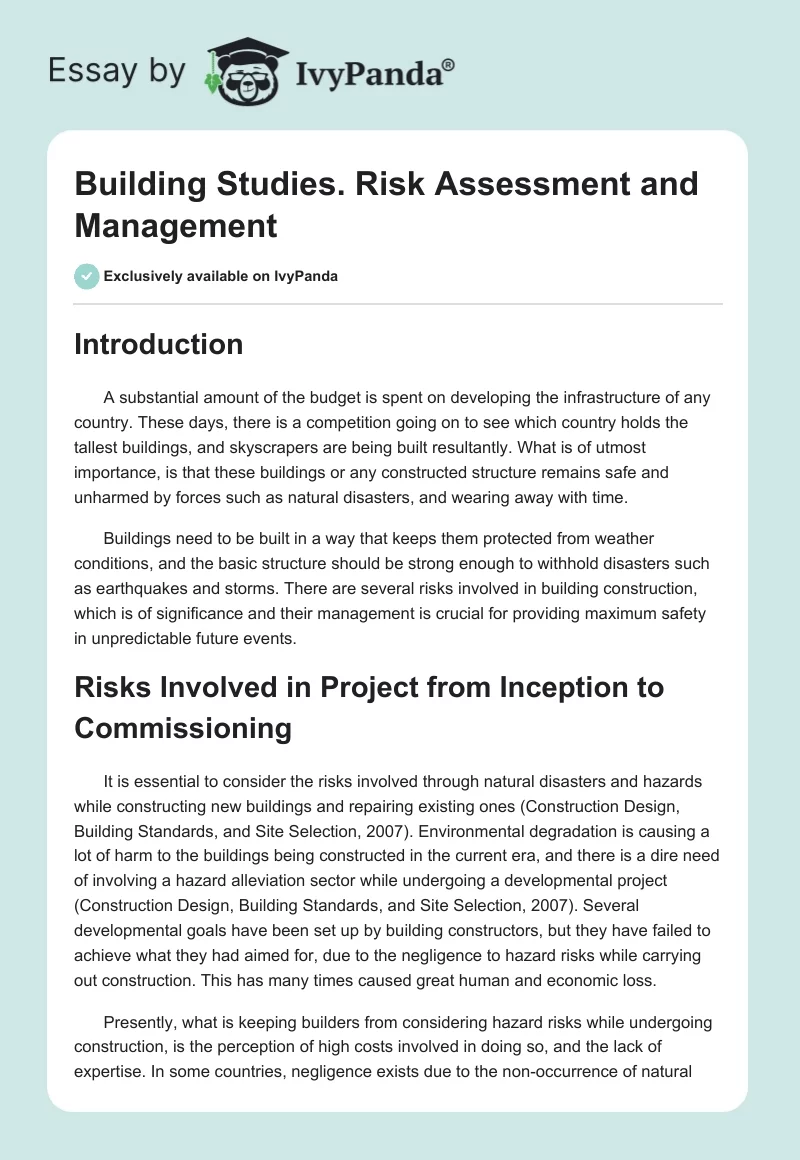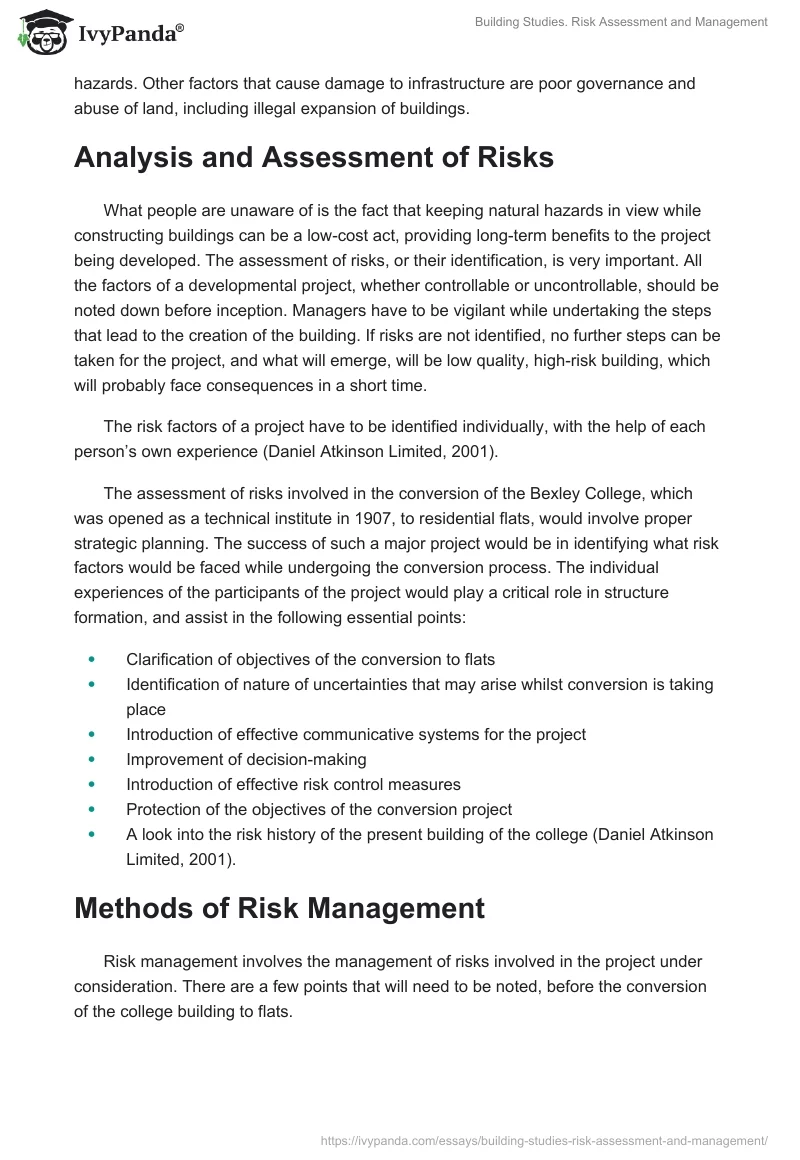Introduction
A substantial amount of the budget is spent on developing the infrastructure of any country. These days, there is a competition going on to see which country holds the tallest buildings, and skyscrapers are being built resultantly. What is of utmost importance, is that these buildings or any constructed structure remains safe and unharmed by forces such as natural disasters, and wearing away with time.
Buildings need to be built in a way that keeps them protected from weather conditions, and the basic structure should be strong enough to withhold disasters such as earthquakes and storms. There are several risks involved in building construction, which is of significance and their management is crucial for providing maximum safety in unpredictable future events.
Risks Involved in Project from Inception to Commissioning
It is essential to consider the risks involved through natural disasters and hazards while constructing new buildings and repairing existing ones (Construction Design, Building Standards, and Site Selection, 2007). Environmental degradation is causing a lot of harm to the buildings being constructed in the current era, and there is a dire need of involving a hazard alleviation sector while undergoing a developmental project (Construction Design, Building Standards, and Site Selection, 2007). Several developmental goals have been set up by building constructors, but they have failed to achieve what they had aimed for, due to the negligence to hazard risks while carrying out construction. This has many times caused great human and economic loss.
Presently, what is keeping builders from considering hazard risks while undergoing construction, is the perception of high costs involved in doing so, and the lack of expertise. In some countries, negligence exists due to the non-occurrence of natural hazards. Other factors that cause damage to infrastructure are poor governance and abuse of land, including illegal expansion of buildings.
Analysis and Assessment of Risks
What people are unaware of is the fact that keeping natural hazards in view while constructing buildings can be a low-cost act, providing long-term benefits to the project being developed. The assessment of risks, or their identification, is very important. All the factors of a developmental project, whether controllable or uncontrollable, should be noted down before inception. Managers have to be vigilant while undertaking the steps that lead to the creation of the building. If risks are not identified, no further steps can be taken for the project, and what will emerge, will be low quality, high-risk building, which will probably face consequences in a short time.
The risk factors of a project have to be identified individually, with the help of each person’s own experience (Daniel Atkinson Limited, 2001).
The assessment of risks involved in the conversion of the Bexley College, which was opened as a technical institute in 1907, to residential flats, would involve proper strategic planning. The success of such a major project would be in identifying what risk factors would be faced while undergoing the conversion process. The individual experiences of the participants of the project would play a critical role in structure formation, and assist in the following essential points:
- Clarification of objectives of the conversion to flats
- Identification of nature of uncertainties that may arise whilst conversion is taking place
- Introduction of effective communicative systems for the project
- Improvement of decision-making
- Introduction of effective risk control measures
- Protection of the objectives of the conversion project
- A look into the risk history of the present building of the college (Daniel Atkinson Limited, 2001).
Methods of Risk Management
Risk management involves the management of risks involved in the project under consideration. There are a few points that will need to be noted, before the conversion of the college building to flats.
Firstly, an analysis will have to be made as to how strong the currently built structure is, and if it can resist further amendments, being an old building. The identification of risks involved in making changes to the building needs to be made.
Secondly, the risks must be evaluated in terms of the chances of occurrence (Klemetti, A., 2006). There has to be an estimation of the likelihood of a risk involved, and how frequently it is prone to occur, in altering the building structure.
Thirdly, the response of the risk is essential to be kept in mind, which usually involves three strategies, acceptance, mitigation, and avoidance.
Lastly, appropriate steps need to be taken for the execution of the project, to see that no hindrances arise in the conversion of the building of the college into residential flats. Another important fact to be considered is that the flats will be under constant wear and tear by dwellers and this will require better quality infrastructure for long-lasting effects.
Conclusion
The transformation of the college building to residential flats needs an understanding of the risk factors involved in doing so, which would involve a thorough study of the current status of the old building, and what steps would be executed to further strengthen the existing structure to house, local dwellers.
Works cited
Anna Klemetti. Risk Management in Construction Project Networks. Helsinki University of Technology, Laboratory of Industrial Management. Report 2006. Web.
Daniel Atkinson Limited (2001) Risk Management in Construction Projects. Web.
Design/Build Negotiated Contract Cuts Risk Of Construction Cost Overruns For Municipalities By ANDY JONES, Senior Vice President of Operations, McLennan & Thebault Inc. Web.
Tools for mainstreaming disaster risk reduction. Construction Design, Building Standards, and Site Selection. Web.


